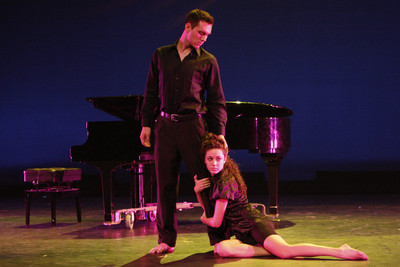Bouquet of Life
Behold a human mosaic.
A passionate potpourri of movement and music and poems and prose.
And Tupac Shakur.
"We are really pushing the limits with our audience, but it's a treat for the eye and the senses," says Jeneane Gallo Huggins, creator of "The Concrete Rose," a genre-crossing kaleidoscope of dance, drama, songs and speech staged for a two-weekend run at the Las Vegas Academy of International Studies, Visual and Performing Arts. "We're trying to paint a beautiful picture through the body and through language."
Blossoming from the streetwise poetry of Shakur, the impassioned imagery of Chilean writer Pablo Neruda and Huggins' own text injecting a feminine sensibility, "The Concrete Rose" fuses the three into performance art rendered by a 55-member cast of Academy dancers and actors dabbling in each other's specialities.
"Some of the dancers have never acted before, so we try to play off that," says 17-year-old dancer Emily McTernan, who does realize the limits of teen performers conveying emotionally complex material. "It's hard, at 17 years old, to feel attached to something you're not even familiar with, but it's fun to see we can be moving in a really abstract way through our eyes, our connectedness."
Adjectives don't quite capture a piece so stylistically adventurous -- but ethereal, dreamlike and impressionistic come close. Thematically, "The Concrete Rose" (the title echoing the late rapper/poet's collection of writings, "The Rose That Grew From Concrete") examines nothing short of ... life.
"Tupac's poetry is very raw and telling, and I knew it would speak to my students, and with Pablo Neruda, he wrote such lovely sonnets to his wife, they both have such a passionate fire," says Huggins, head of the Academy's dance department. "My voice is probably the simplest to understand, but I wanted three different perspectives. It's about passion and the human condition and living life to its fullest, even though there may be conflict in your life, and what's important in your life."
Minus character names and linear narratives, the series of scenes mine the essence of life's journeys via poetry recitations and straight dialogue set to an eclectic recorded soundtrack and choreography both sweeping in ensembles and cozy in duets.
"This piece is special because it's original, it isn't something we picked. It's a piece that Ms. Huggins wrote, she poured herself into it," says 17-year-old performer Jeff Zicker. "Bits of poetry, bits of choreography, they all have a unifying message. Americans are hopeful now, and maybe with this, we can give our patrons a greater sense of that."
Shakur's expressions are explored in numerous pieces, including "In the Depths of Solitude," addressing a soul's dual personas, and "The Family Tree," a reflection of racial pride. "It's about being proud of your heritage and your family tree," Huggins says. "It says he was proud to have sprung from a different branch. It's a rap poem, very subtle but very powerful."
In a Neruda-flavored vignette about housewives, female dancers draped in a rainbow array of aprons glide over the stage wielding spatulas, dustpans, blenders, cheese graters and irons, as husbands weave around them. "It's about being a housewife as a good thing, like 'I love you so much, I just want to put on an apron and iron your clothes,' " Huggins says. "It's not a lifetime of that, but I think every woman has a moment that you feel like you want to take care of somebody."
For "The Face," co-conceived by Huggins and student Chelsea Thedinga, a young woman appraises her appearance and deconstructs her facial features, reciting: "Will you fall in love with me today? Is my blond hair bright enough? ... My green eyes green enough?"
Huggins characterizes her writing style as (David) Mamet-esque. "Not the bad language," she stresses, "but only needed imagery, the sense of finding what you need to find by not saying too much."
Another scenario, drawn from Neruda, seductively celebrates the tango, one couple multiplying into many, the stage a de facto ballroom. "It's distinctly poking fun at the fact that sometimes males don't know what they're doing and the females do," McTernan says. "That's where humor is, so it's not quite so heavy."
Yet another piece depicts the delights of letter writing and sharing long-distance intimacies more personally, pen-to-paper (e-mail junkies, take note). "Having boxes of letters that a lover may have written," Huggins says, "that sense of permanency of letter writing."
Merely another tile in the human mosaic.
"The Concrete Rose" aspires to be a quilt of our quirks, a potpourri of our pleasures, a medley of our lives.
Contact reporter Steve Bornfeld at sbornfeld@ reviewjournal.com or 702-383-0256.
Preview "The Concrete Rose" 7 p.m. today, Saturday and Thursday (through Dec. 20) Lowden Theater for the Performing Arts, Ninth Street and Clark Avenue $12 (800-585-3737)














